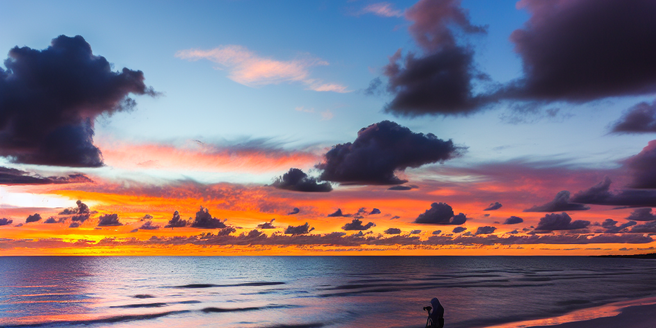
Choosing the Right Equipment for Sunset Photography
When capturing sunsets, the right equipment can significantly impact your results. A quality camera body with good dynamic range is crucial to handle varying light conditions. Pair it with a versatile lens, such as a 24-70mm, to capture wide landscapes or zoom in on specific details. A sturdy tripod is invaluable to stabilize your shots, especially in low light. Consider using a neutral density (ND) filter to manage highlights and reduce glare. Having a remote shutter release further minimizes camera shake, ensuring sharp images. While gear can make a difference, remember the equipment’s role is to serve your creative vision. Ultimately, understanding your tools and their capabilities will allow you to experiment with different techniques, resulting in breathtaking sunset photos that capture the essence of the moment.
Understanding Light and Composition
Understanding light and composition is essential for capturing stunning sunset photographs. The golden hour offers warm, soft light, perfect for landscape photography. Pay attention to the direction and quality of light as it changes rapidly during sunset. Use leading lines or foreground elements to guide the viewer’s eye and add depth to your images. Experiment with the rule of thirds to create balanced and harmonious compositions. Reflections in water bodies can add a dramatic effect, doubling the beauty of the sunset in your frame. Be mindful of the horizon and consider placing it off-center for a more dynamic shot. The interplay of shadows and light creates dramatic effects, so embrace them as part of your composition. Mastering these elements allows you to create captivating and emotionally resonant sunset photographs.
Mastering Camera Settings at Sunset
Mastering camera settings at sunset can make the difference between a mediocre photo and a masterpiece. Start with a low ISO setting to maintain image quality and reduce noise. Use aperture priority mode to control depth of field; wider apertures (f/2.8-f/5.6) can create a beautiful bokeh effect while narrower ones (f/8-f/16) offer greater sharpness throughout the frame. The shutter speed will depend on the available light—faster speeds freeze motion while slower ones are excellent for capturing silky water movements. Bracketing exposures can help manage challenging lighting, allowing you to choose the best-balanced shot later. Consider shooting in RAW format to preserve more detail in shadows and highlights, which is especially useful during post-processing. Being adept with these settings ensures you capture sunsets in all their vivid, dynamic glory.
Creative Techniques for Capturing Sunsets
Capturing sunsets with creativity involves exploring unique techniques to emphasize mood and atmosphere. Long exposure is a popular choice; it smooths out water, blurs clouds, and softens light trails, transforming scenes into ethereal images. Silhouettes are another dramatic technique. Position subjects—people, trees, structures—against the bright sky to create striking contrasts and powerful shapes. Adding lens flares can inject warmth and dynamism into photos, but it needs careful consideration to avoid washing out details. High Dynamic Range (HDR) photography blends multiple exposures to ensure a greater range of shadows and highlights, ideal for sunset scenes with extreme contrasts. Experimenting with white balance can also shift the colors of your sunset, adding artistic flair. By incorporating these techniques, photographers can elevate their sunset images beyond the ordinary.
Post-Processing Tips for Enhancing Sunset Photos
Post-processing is vital for enhancing sunset photos, bringing out their full potential. Begin by adjusting exposure and contrast to refine the balance between highlights and shadows. Fine-tune the white balance to achieve the desired warmth or coolness in your image. Increase vibrance and saturation to emphasize the colors of the sunset without oversaturating. Use the gradient tool to subtly enhance the sky’s colors and add depth to the foreground. Sharpening will clarify details, while noise reduction helps in reducing noise from higher ISO settings. Consider using selective adjustments to highlight specific areas, guiding the viewer’s attention. Dodging and burning can add dimension, enhancing the mood of the scene. A well-executed post-processing workflow allows for a more polished and impactful sunset photograph.
